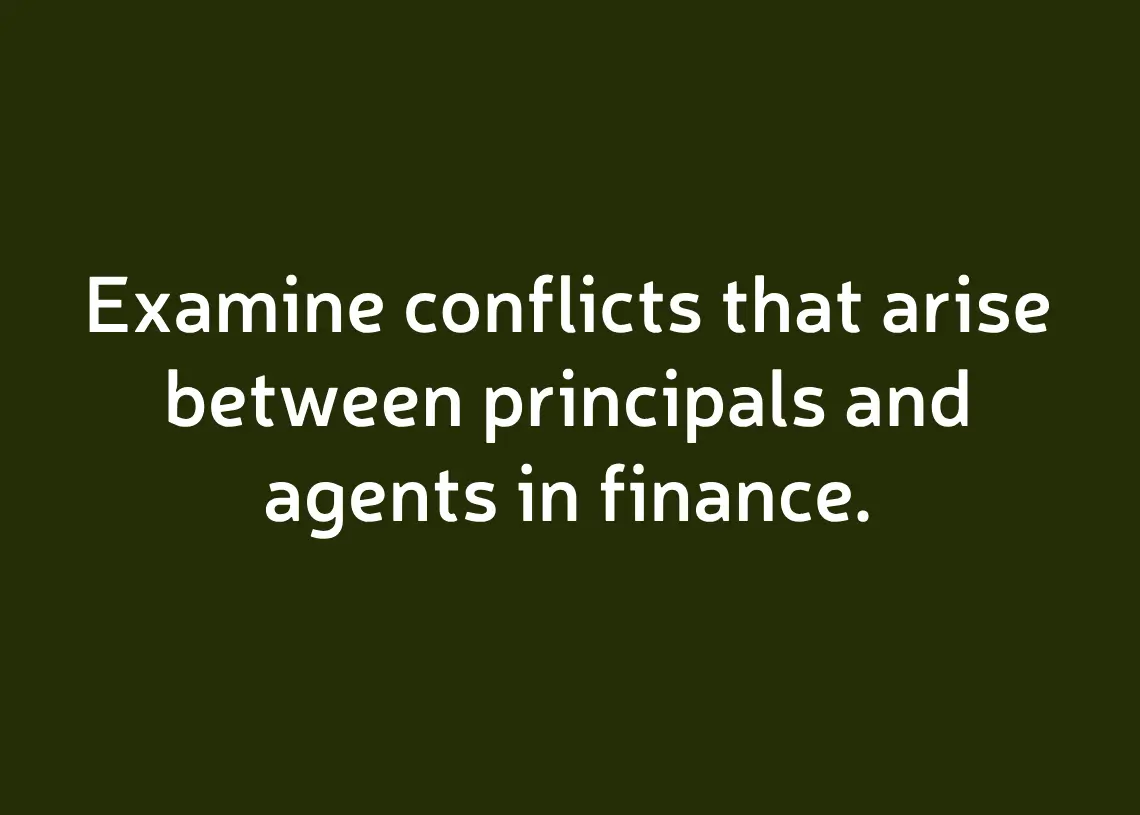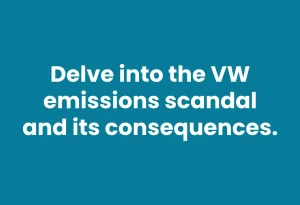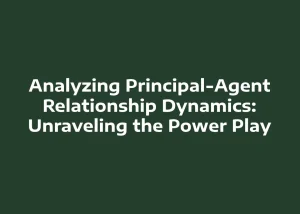In the world of finance, conflicts between principals and agents are a common occurrence. Principals, who are the owners of assets, often delegate their decision-making authority to agents, who are hired to manage these assets on their behalf. While this delegation of authority can be advantageous for principals, it also introduces potential conflicts of interest that can negatively impact both parties.
In this blog post, we will examine the common conflicts that arise between principals and agents in finance. These conflicts can take various forms, such as information asymmetry, goals misalignment, and moral hazard. We will discuss the causes of each type of conflict, how they can harm the relationship between principals and agents, and what strategies principals can use to mitigate the risk of such conflicts.
Furthermore, we will explore the role of financial intermediaries, such as investment banks and brokerages, in managing conflicts between principals and agents.
Earn a certificate in your dream career for an affordable price at IAP Career College today!
Principal-agent conflicts and their significance
In finance, a principal-agent conflict refers to a situation where the interests of a principal and its agent are not aligned. This conflict arises when the principal hires an agent to act on its behalf but cannot fully monitor or control the actions of the agent.
In such situations, the agent may pursue actions that benefit themselves at the expense of the principal. This conflict can occur in various financial relationships, such as between shareholders (principals) and managers (agents) of a company, between investors (principals) and fund managers (agents), or between borrowers (principals) and lenders (agents).
Principal-agent conflicts are significant because they can lead to inefficiencies, reduced profits, and even financial scandals. To mitigate these conflicts, principals can use contracts, incentives, and monitoring mechanisms to align the interests of agents with their own.
Agency problems: moral hazard
Principal-agent conflicts are common in finance and can occur due to issues such as information asymmetry, differing priorities, and moral hazard. One of the most significant agency problems is moral hazard, where agents may act in their own self-interest instead of carrying out the principal’s goals.
This occurs when agents are incentivized to take actions that maximize their own benefits, even if it comes at the expense of the principal. For example, a financial advisor may recommend risky investments to a client to earn a higher commission, even if it is not in the client’s best interest.
To mitigate this issue, principals must design incentive structures that align with their goals and monitor the agent’s behavior closely. Additionally, implementing ethical codes of conduct and providing education on ethical behavior can help to reduce the likelihood of moral hazard.
Who bears the risk?
In the realm of finance, conflicts can arise between principals and agents, commonly referred to as principal-agent conflicts. One common issue in these conflicts is determining who bears the risk. Principals may be hesitant to take on too much risk, while agents may be incentivized to take risks in order to generate higher profits.
This misalignment of interests can lead to conflicts and potential losses for both parties. It is important for both principals and agents to clearly define and agree upon the level of risk that is appropriate for their specific situation in order to avoid conflicts and ensure a mutually beneficial relationship.
Effective communication and transparency between both parties can also help to mitigate the risk of principal-agent conflicts.
How to manage conflicts
In the field of finance, principal-agent conflict is a common occurrence that arises between principals and agents. Managing conflicts is therefore a critical skill that is essential in ensuring the success of any business relationship.
When conflicts arise between principals and agents, it is important to address them in a timely and professional manner to avoid damaging the relationship and negatively impacting the business. One effective way to manage conflicts is to establish clear expectations and guidelines at the outset of the relationship.
This can include clearly defining roles and responsibilities, setting performance metrics, and outlining communication protocols. Another important strategy is to maintain open lines of communication and encourage regular feedback to ensure that both parties are aligned and working towards the same goals.
Additionally, it may be helpful to engage a neutral third party to mediate any conflicts that cannot be resolved through direct communication. By following these best practices, principals and agents can effectively manage conflicts and build strong, mutually beneficial relationships in the field of finance.
Aligning interests with incentives
One effective way to manage principal-agent conflicts in finance is by aligning interests with incentives. This approach aims to create a shared goal for both the principal and agent, thereby minimizing potential conflicts.
One example of this approach is performance-based compensation, which rewards agents for meeting or exceeding specific targets. By linking the agent’s compensation to the principal’s interests, the agent will be more motivated to work towards achieving the principal’s objectives.
Another example is setting clear expectations and defining roles and responsibilities, which helps ensure that both parties are working towards the same goals. By aligning interests with incentives, principal-agent conflicts can be mitigated, and both parties can benefit from a mutually beneficial relationship.
Introducing monitoring mechanisms
Introducing monitoring mechanisms is a crucial step in mitigating principal-agent conflict in finance. This type of conflict arises when a principal hires an agent to act on their behalf, but the agent’s interests do not align with those of the principal.
By implementing monitoring mechanisms, principals can keep a close eye on their agents to ensure they are acting in the best interest of the principal. This can include regular performance evaluations, frequent communication, and the use of financial incentives to motivate agents to act in the interest of the principal.
Without these monitoring mechanisms in place, principal-agent conflict can lead to a breakdown in trust and ultimately damage the financial interests of all parties involved. Therefore, it is imperative for principals to implement effective monitoring mechanisms to ensure the success of their financial ventures.
Contractual agreements and their role
In finance, the principal-agent conflict can arise between a principal and an agent when the agent is not acting in the best interest of the principal. This conflict can be mitigated through contractual agreements that establish a clear understanding of the roles and responsibilities of both parties.
These agreements outline the terms of the relationship, including the goals, compensation, and expectations of each party. Additionally, they can provide remedies for breach of contract or failure to meet obligations.
By establishing clear and concise contractual agreements, both the principal and the agent can have a comprehensive understanding of their roles and responsibilities, reducing the likelihood of conflicts arising in the relationship. It is essential to ensure that these agreements are properly drafted and reviewed to avoid any misunderstandings and to protect the interests of both parties.
Disclosure and transparency practices
One of the key ways to mitigate principal-agent conflict in finance is through strong disclosure and transparency practices. These practices involve providing clear and detailed information to the principal about the actions and decisions made by the agent on their behalf.
This includes disclosing any potential conflicts of interest or financial incentives that may influence the agent’s behavior. By providing this information, the principal is better equipped to evaluate the agent’s actions and ensure they align with their best interests.
Additionally, transparency practices can help facilitate trust between the principal and agent, which is essential for a successful and mutually beneficial relationship. It is important for financial institutions and professionals to prioritize these practices to maintain ethical standards and build long-term relationships with their clients.
Mitigating the agency costs
One of the most significant challenges that arise in the field of finance is the Principal-agent conflict. This conflict occurs when the interests of the principal (the owner of the assets) diverge from those of the agent (the person who manages the assets on behalf of the principal).
The principal-agent conflict can lead to a misalignment of incentives, which in turn can lead to agency costs. Mitigating these costs is crucial, and there are several strategies that can be employed to do so. One way is to create a contract that explicitly states the expectations and responsibilities of both the principal and agent.
Another is to provide performance-based incentives that align the interests of both parties. Finally, providing adequate monitoring and oversight can ensure that the agent acts in the best interests of the principal and help to reduce agency costs. By implementing these strategies, the principal-agent conflict can be managed, and the interests of both parties can be aligned, resulting in a more effective and efficient management of assets.
Choosing the right agent
The principal-agent conflict is a common problem in finance, where the interests of the principal and agent may not always align. As a result, it is crucial to choose the right agent to represent your interests. When selecting an agent, it is important to consider their experience, qualifications, and track record.
Look for an agent who has a deep understanding of the industry and has a proven track record of success. Additionally, make sure that the agent is licensed and regulated by a reputable governing body. This will ensure that they are held to high ethical and professional standards. By choosing the right agent, you can minimize the risk of principal-agent conflict and increase the likelihood of achieving your financial goals.
Conclusion: Resolving Principal-Agent Conflicts
In conclusion, conflicts between principals and agents in finance are common, but they can be managed effectively through proper communication, transparency, and alignment of interests. Principals should establish clear expectations and guidelines for agents, and agents should be proactive in communicating progress and challenges to principals. Additionally, performance metrics and incentives should be structured in a way that aligns the interests of both parties. By taking these steps, principals and agents can work together to achieve mutual goals and ensure the success of their financial activities.
FAQs:
What is an example of a principal agency problem?
A principal-agent problem is a situation where one party (the principal) hires another party (the agent) to act on their behalf, but the agent may have different incentives than the principal, leading to the agent taking actions that are not in the best interests of the principal.
One common example of a principal-agent problem is the relationship between shareholders and managers of a corporation. Shareholders are the principals, and managers are the agents. Shareholders want the company to maximize profits, but managers may have other incentives, such as increasing their own compensation or power. This can lead to managers making decisions that are not in the best interests of shareholders, such as taking on excessive risk or paying themselves too much.
Another example of a principal-agent problem is the relationship between insurers and policyholders. Policyholders are the principals, and insurers are the agents. Policyholders want to minimize their insurance premiums, while insurers want to maximize their profits. This can lead to insurers denying claims or offering policies that are not in the best interests of policyholders.
Other examples of principal-agent problems include:
- A doctor recommending unnecessary medical procedures to increase their earnings.
- A real estate agent selling a home to a buyer for less than the seller could have gotten if the agent had put in more effort to market the home.
- A car mechanic overcharging a customer for repairs.
- A politician voting for a bill that benefits a special interest group even though the bill is not in the best interests of their constituents.
Principal-agent problems can be costly, and there are a number of ways to try to mitigate them. One common approach is to align the incentives of the agent with those of the principal. For example, shareholders can elect a board of directors that is responsible for overseeing the management of the company. The board of directors can then tie the compensation of managers to the performance of the company.
Another way to mitigate principal-agent problems is to increase transparency. If the principal has more information about the actions of the agent, they can better detect and deter self-serving behavior. For example, insurers often require policyholders to provide detailed information about their medical history and driving record. This information helps insurers to assess the risk of insuring a particular individual and to set premiums accordingly.
Principal-agent problems are a complex issue, and there is no one-size-fits-all solution. However, by understanding the problem and the available solutions, principals can take steps to reduce the risk of being exploited by their agents.
What is principal principal conflict CFA?
A principal-principal conflict in CFA refers to a situation where two or more principals (e.g., shareholders, board members, or controlling owners) have different interests and objectives, which can lead to conflicts that harm the company as a whole.
One example of a principal-principal conflict is when a company has controlling shareholders who have different interests than the minority shareholders. For example, the controlling shareholders may want to extract cash from the company by paying themselves high dividends, even if this means that the company has less money to invest in growth. This can harm the minority shareholders, who may be more interested in seeing the company grow in value over time.
Another example of a principal-principal conflict is when there is a disagreement between the board of directors and the management team. The board of directors is responsible for overseeing the management team and ensuring that they are acting in the best interests of the company. However, sometimes the board of directors may be controlled by directors who have their own interests at heart, such as directors who are also executives at the company. This can lead to conflicts between the board of directors and the management team, which can harm the company.
Principal-principal conflicts can be difficult to resolve, but there are a number of things that can be done to mitigate them. One important step is to have a strong corporate governance structure in place. This includes having a board of directors that is independent of management and that has the authority to oversee the management team. It is also important to have clear and transparent communication between the board of directors, management team, and shareholders.
CFA Institute members have an obligation to avoid conflicts of interest, and this includes the obligation to disclose any known conflicts of interest to their clients. CFA Institute members also have an obligation to act in the best interests of their clients, even when this means putting the client’s interests ahead of their own.
Here are some tips for CFA Institute members on how to avoid principal-principal conflicts:
- Be aware of the potential for principal-principal conflicts in your client relationships.
- Disclose any known conflicts of interest to your clients.
- Act in the best interests of your clients, even when this means putting the client’s interests ahead of your own.
- Seek guidance from CFA Institute if you are unsure of how to handle a potential conflict of interest.





